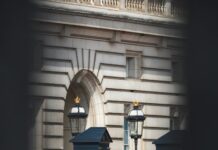London, the vibrant capital of the UK, is a city that never fails to captivate. Have you ever wondered how the zip code of UK London can be a gateway to exploring its diverse neighbourhoods? With over 100 different postcodes in London, each area boasts its own unique charm and character, making it essential for anyone looking to navigate this bustling metropolis. From the chic streets of Chelsea to the historic vibes of Greenwich, understanding the London zip code system not only aids in finding your way but also unlocks a treasure trove of hidden gems. Did you know that each postcode can reveal fascinating insights about the local community? In this article, we’ll delve into the intricacies of London postcodes, exploring how they influence everything from property prices to local amenities. Are you curious about how these codes can affect your next visit or move to the city? Join us as we uncover the secrets behind the postcode system in London and learn why it matters more than you might think. Don’t miss out—your journey through London starts here!
Uncover the Secret: How to Find Your Ideal London Zip Code for Home and Work
When it comes to the zip code of UK London, one could say it’s a bit of a maze. I mean, London is huge, right? And, there’s like, a million different postcodes (or should I just say zip codes?) that can confuse even the most seasoned Londoners. Not really sure why this matters, but it’s one of those things that can make or break your experience in this bustling metropolis.
Now, I don’t wanna bore you with the nitty-gritty, but London’s postal system is actually quite fascinating. It’s divided into several regions, and each postcode usually starts with a letter (like E for East, NW for North-West, and so on). Each area has its own unique vibe; it’s like the city’s personality is reflected in these codes.
A quick look at the table below shows some of the main postcode areas in London:
| Postcode Area | Description | Notable Areas |
|---|---|---|
| E | East London | Bethnal Green, Hackney |
| NW | North West London | Camden, Kilburn |
| SW | South West London | Chelsea, Wimbledon |
| SE | South East London | Greenwich, Peckham |
| W | West London | Notting Hill, Kensington |
| EC | City of London | Financial District |
These codes are more than just letters and numbers; they’re, um, sorta like a badge of honour for the streets they represent. I mean, can you imagine living in W1A? Sounds pretty snazzy, right? But then, there’s also the less glamorous sides of the postal system, like E7, which is not really the most exciting zip code of UK London.
If you’re thinking about moving to London, or even just visiting, it’s good to know a bit about these postcode areas. Like, say you’re looking for a trendy place to grab a coffee in East London. You’d probably wanna check out E2 or E1, right? Those areas are buzzing with cafes and art vibes.
Here’s a little breakdown of some popular postcode areas and what they’re known for:
E1: Known for Whitechapel and Brick Lane, it’s the place to go for curry and a great street art scene.
NW3: If you’re fancying Hampstead Heath, then NW3 should be on your radar. It’s posh, but you know, in a charming way.
SW1: This area is home to Buckingham Palace and is a tourist hotspot. But hey, who doesn’t wanna see the Queen’s pad?
SE5: Camberwell is where you wanna be for a more laid-back vibe, with art galleries and pubs galore.
W11: Notting Hill is the place for colourful houses and, of course, the famous Notting Hill Carnival.
So, why is knowing your zip code of UK London important, you ask? Well, when you’re ordering a takeaway or trying to get a cab, trust me, having the right postcode saves you a lot of hassle. You don’t wanna be that person, standing outside in the rain, while your pizza is somewhere totally wrong.
And let’s not forget the postal code’s impact on property prices. If you’ve got an SW postcode, chances are your flat is gonna cost an arm and a leg compared to a more “average” postcode like E9. It’s all about location, location, location, as they say.
Now, for the fun stuff, sometimes people use postcodes as a slang term, like “I live in the E3 area” and it signals a certain lifestyle. It’s kind of like a code, if you will. But, maybe it’s just me, but I feel like some folks take their postcodes way too seriously. I’ve heard of people who, like, won’t even consider dating someone from a different postcode. Talk about postcode snobbery!
If you’re planning to send a letter or a parcel, here’s a quick guide on how to format your address properly:
- Recipient’s Name
- Street Address
- Postcode (Like E2 8AA)
- City (LONDON)
Seems pretty straightforward, right? But you’d be surprised how many folks get it wrong. I mean, come on, how hard can it be?
In recent years, there have been some changes and updates to the postal system, especially with the rise of online shopping. It’s become more important than ever to ensure that your zip code of UK London is accurate, or else your new shoes might end up in the wrong postcode entirely. And no one wants to deal with that drama.
So,
A Comprehensive Guide to London Zip Codes: Which Area Fits Your Lifestyle?
When it comes to London, the whole place is a melting pot of cultures, people, and let’s not forget, postal codes. Yep, that’s right, the zip code of UK London is not just a random string of letters and numbers. It’s like a secret code that tells you where you are in this massive city. But honestly, who keeps track of all them? Not really sure why this matters, but I guess it does if you’re sending a letter or something.
So, first off, London isn’t just one postcode, it’s several! You got the famous ones like WC1, which is for areas like Bloomsbury and Kings Cross, and then you got E1 for the East End, which is cool and all. They call it a postcode district, but it’s really just a fancy way of saying “we can’t be bothered to name every single street.” I mean, maybe it’s just me, but I feel like it’s a bit of a daft system when you think about it.
Here’s a little breakdown of some of the key postcode areas in London. And by the way, I hope you’re ready for a bit of a rollercoaster because this list is long!
| Postcode Area | Description | Notable Locations |
|---|---|---|
| WC1 | Central London, near universities | UCL, British Museum |
| E1 | East London, a mix of culture and history | Whitechapel, Brick Lane |
| SW1 | The heart of Westminster | Buckingham Palace, Big Ben |
| N1 | North London, trendy and vibrant | Islington, Camden Town |
| SE1 | South of the river, loads of attractions | London Eye, Tate Modern |
Now, if you’re wondering how these zip codes of UK London actually work, let’s just say it’s a bit of a puzzle. Each postcode is divided into two parts – the area and the district. Like, WC1 is the area and 1 is the district. I mean, why not just make it easier and have a single code? But whatever, that’s how it goes.
Most people are probably familiar with the London postal codes which get thrown around, like when people are bragging about living in a certain area. “Oh, I live in SW1, you know, the posh part.” It’s like a badge of honour or something. But let’s be real, it’s just a number. Not that I’m bitter or anything!
If you’re thinking of moving to London, you might wanna think about which postcode you wanna call home. It’s a big deal, trust me. Different areas have different vibes, and some might be more your cup of tea than others. Like, if you prefer a quieter life, maybe avoid E1 where the nightlife is buzzing. Or if you like a bit of drama, then go for it!
But let’s not kid ourselves. The zip code of UK London can also affect your rent. I mean, if you’re living in SW1, you’ll likely be paying through the nose for a shoebox flat, while in E1, you might snag a bit more space for less cash. But hey, space isn’t everything, right?
Another interesting thing about London’s postal codes is that they don’t just tell you where you live; they can also give you a clue about the history of the area. For example, areas like WC1 have roots that trace back to the old Westminster city, which is pretty cool if you’re into that kind of stuff. But, I mean, who isn’t fascinated by a bit of history?
Here’s a few more handy insights about the zip codes of UK London you might not know:
Postal codes can change! Yup, if an area gets too populated or, I dunno, just has a lot of new buildings, they might decide to add an extra letter or something. Talk about keeping you on your toes!
Some postcode areas are more desirable than others, and it’s all about perception. Like, if you say you live in E1, there’s a certain street cred that comes with it. It’s all about that image, baby!
Not all postcodes are created equal. Some can have a reputation for being a bit dodgy, while others are seen as the crème de la crème. It’s a bit like high school, where everyone’s trying to figure out who’s who.
Oh, and let’s not forget about the London zip code system being used for more than just mail. It’s often used for delivery services and even online shopping. So, when you’re ordering your next pair of shoes, remember your postcode might just determine how quickly they get to your door.
In summary, London’s postcode system is a
The Ultimate London Zip Code List: Your Key to Understanding Neighbourhoods
Alright, let’s dive into the quirky world of London zip codes, or as they call ’em, postcodes, which is a right mouthful, innit? If you’re ever wondered about the zip code of UK London, you’ve come to the right place. Not that it’s the most thrilling topic ever, but hey, we all gotta start somewhere, right?
First off, London’s postcode system is like a maze, or maybe a jigsaw puzzle with pieces missing. It’s divided into different areas, with each area having its own set of codes. The main ones are the famous ones, like SW1A, which is where the Queen’s got her gaff. Seriously, imagine sending a letter to Her Majesty and getting the postcode wrong. I mean, what a faux pas!
| Area | Postcode |
|---|---|
| Westminster | SW1A |
| Camden | NW1 |
| Greenwich | SE10 |
| Islington | N1 |
So, like, if you’re looking at the London zip code, SW stands for South West and it’s pretty self-explanatory. I always thought that it’s funny how they’ve got these letters and numbers all jumbled together. Makes you wonder who came up with this system, really. Maybe it was a bored civil servant?
Moving on, there’s also the classic EC postcode, which stands for East Central, and that’s where the City of London is. You know, the financial district? It’s also where everyone goes to pretend they’re busy in a suit, drinking overpriced coffee. Not really sure why this matters, but it does.
Now, if we’re talking about the zip code of UK London, we can’t forget about the tube stations. Every station has a postcode, which is just brilliant for those who can’t navigate without their phone. I mean, who needs maps these days? Here’s a little table for ya:
| Station | Postcode |
|---|---|
| Kings Cross | N1 9AL |
| Oxford Circus | W1B 3AG |
| Victoria | SW1E 5JL |
| London Bridge | SE1 9SG |
Funny enough, each postcode zone can sometimes be a bit of a nightmare. Some areas overlap, and it’ll make your head spin trying to figure out where one ends and another starts. The confusion is real! Maybe it’s just me, but I feel like they could’ve made it a bit simpler.
And let’s not forget about the outer zones. You’ve got places like NW and E that cover a massive area. The zip code of UK London is nothing if not extensive. For instance, E1 is all the way in East London, which is famous for its markets and hipster vibes. You know the type: beards, flannel shirts, and all that jazz.
Here’s a fun fact: the further out you go, the cheaper the rent tends to be. But you might find yourself living miles away from the city centre, which can be a right pain if you’re commuting. Here’s a nifty little sheet that shows you some of the more affordable outer London postcodes:
| Area | Average Rent (per month) |
|---|---|
| Barking | £1,200 |
| Croydon | £1,400 |
| Enfield | £1,300 |
| Bexley | £1,250 |
Now, if you’re planning on moving to London or just visiting, knowing the zip code of UK London is super important. It helps you navigate the city, and if you’re ordering a takeaway, you don’t wanna end up with cold pizza because you gave the wrong postcode, right?
Oh, and here’s a quick tip – if you ever find yourself in a pickle with the postcode, just use Google Maps. It’s not foolproof, but it’s better than guessing! I mean, who really wants to end up in the wrong part of town, especially in London’s more dodgy areas?
Moreover, there’s this whole thing about how postcodes can actually affect property prices. Areas with trendy postcodes can see their house prices skyrocket, while less desirable areas might struggle. It’s a postcode lottery, quite literally!
So, if you’re ever in doubt about the zip code of UK London, just remember it’s more than just numbers and letters. It’s a whole culture, a way of life, and a key to navigating one of the most vibrant cities in the world. It’s like a treasure hunt, really, but instead of gold, you get to find your new favourite coffee shop! Just make sure you’ve got the right postcode before you set out
Top 5 London Areas with the Best Zip Codes for Young Professionals in 2023
When ya think about London, ya probably picture the iconic Big Ben, the bustling streets, and, of course, the zip code of UK London. Now, zip codes or postcodes, whatever ya wanna call ’em, they can be a bit of a maze. Seriously, there’s like a whole system to them, and sometimes, I’m not really sure why this matters, but it does, apparently!
So, London postcodes are divided into several areas, and each area got its own unique code. It’s all a bit bonkers, if ya ask me. The main ones, ya know, like EC1, NW3 and SW8, all have their own special charm. Here’s a quick rundown of a few of the popular ones:
| Area | Postcode | Notable Places |
|---|---|---|
| East Central | EC1 | St. Paul’s Cathedral |
| North West | NW3 | Hampstead Heath |
| South West | SW8 | Battersea Park |
| South East | SE1 | The Shard |
So, if ya live in EC1, that means ya in East Central London. Not to sound posh or anything, but it’s like the heart of London. I mean, who wouldn’t want to live near St. Paul’s Cathedral? But, the rents are like sky-high.
Now, let’s talk about zip code of UK London in a bit more detail. The postcode system was introduced in the 1950s, which is a long time ago, like before most of us were even born. The idea was to make sorting mail easier, but let’s be honest, it’s turned into a bit of a pain in the backside for most folks.
Each postcode is made up of two parts: the outward code and the inward code. The outward code tells ya which area you’re in and the inward code specifies the exact location. So, for example, in NW1 6XE, NW1 is the area and 6XE is the specific part of that area. It’s a bit like a treasure map, but instead of gold, you’re just trying to find a coffee shop or something, right?
Now, here’s where it gets a bit silly. Some areas have multiple postcodes, and then ya got those that only have one. It’s like, why does Chelsea need a bunch of them while some poor area gets stuck with just one? Maybe it’s just me, but I feel like there should be some consistency.
And let’s not forget about the famous postcode lottery in London – no, not the one ya think of with money, but the one where living in a certain postcode can mean ya pay through the nose for rent. I mean, who wouldn’t want to pay £2,000 a month for a shoebox in Notting Hill, just because it’s trendy?
Oh, and speaking of trendy, if ya check out the zip code of UK London, ya can see how certain areas have shot up in popularity. Like, Shoreditch was once a no-go zone, but now it’s like the hipster capital of the world. Got all those cool cafes, street art, and the smell of overpriced avocado toast wafting through the air.
Here’s a list of some of the most expensive postcodes in London:
- SW1A (Westminster)
- W1K (Mayfair)
- NW8 (St John’s Wood)
- EC2N (Bishopsgate)
Can ya believe that? People are dropping serious cash just to say they live in these areas. It’s like, do you really need to live where the Queen lives? But hey, if ya got the dosh, go for it!
Now, not all postcodes are created equal, and that’s where the fun begins. Some areas are known for their nightlife, while others are more about the quiet, suburban life. If ya fancy a night out, ya might wanna stick to places like Shoreditch or Soho, where the bars are packed and the clubs are bumpin’.
But if ya prefer a more chilled vibe, areas like Richmond or Hampstead are perfect for ya. They got lovely parks and a more laid-back atmosphere. Just keep in mind that the zip code of UK London can really dictate the vibe of ya neighbourhood.
| Postcode Area | Vibe | Best For |
|---|---|---|
| Shoreditch | Hipster | Nightlife |
| Richmond | Suburban | Parks |
| Soho | Vibrant | Dining |
| Hampstead | Nature | Relaxing |
So, whether ya’re looking for a bustling area full of life or a quiet spot to unwind, London’s postcode system has ya covered. Just remember, ya might have to dig a bit deep in your pockets depending on where ya end up.
Isn’t it wild
How to Use London Zip Codes to Discover Hidden Gems in the Capital: A Local’s Guide
When it comes to London, the zip code system, or as they call it over there, the postcode system, can be a bit of a maze, right? I mean, who really understands it all? Not really sure why this matters, but it’s one of those things that can either make your life easier or drive you bonkers. So, let’s dive into the world of the zip code of UK London and see what we can unearth.
Firstly, it’s important to note that London is split into several postcode areas. Each area has its own unique set of codes. You got your NW for North West London, WC for the West Central, and then there’s EC for East Central. Confusing, right? It’s like they just threw letters at a wall and hoped for the best. And don’t even get me started on the fact that some areas have multiple postcodes. Like, why? Are we trying to make it harder for delivery drivers?
| Postcode Area | Description | Example Postcodes |
|---|---|---|
| NW | North West London | NW1, NW2, NW3 |
| EC | East Central London | EC1, EC2 |
| WC | West Central London | WC1, WC2 |
| SE | South East London | SE1, SE2 |
| SW | South West London | SW1, SW2, SW3 |
So, you get the gist. Each of these postcode areas cover a specific part of the city. But, here’s where it gets a tad more complicated: within these areas, there are also sub-districts which have their own unique codes. For instance, NW3 is for Hampstead. Who even knew Hampstead was so fancy, eh?
Now, for those of you who are maybe a bit lost in this postcode jungle, let’s talk about how these zip codes work in practice. If you’re sending a letter, you’ll need to include the full postcode. This means writing something like “123 High Street, NW1 1AA.” But, what’s with the two letters at the end? It’s like a secret code only the postman knows.
Maybe it’s just me, but I feel like the more letters you add, the less sense it makes. Just give me the number, and I’ll find the place, thank you very much! But no, we have to complicate things.
Anyway, what’s the deal with London postcodes and their quirks? Well, for starters, each postcode represents a specific geographic area. This means that a postcode can cover anything from a single building to a whole street. Yep, that’s right. You could have the same postcode for a tiny flat and a massive mansion. How’s that for equality?
Now, let’s take a look at some key zip codes in London, just to get a feel for what we’re dealing with here.
- SW1A 1AA – The famous Buckingham Palace. You know, where the Queen used to live.
- EC3M 4BJ – The Tower of London. Historic, isn’t it?
- W1A 1AA – BBC Broadcasting House. For your daily dose of news.
| Notable Locations | Zip Code |
|---|---|
| Buckingham Palace | SW1A 1AA |
| Tower of London | EC3M 4BJ |
| BBC Broadcasting House | W1A 1AA |
These postcodes are not just for sending letters, you know. They also play a role in property prices, businesses, and even school catchment areas. Yup, if you live in a posh postcode, your house value might be sky-high. But if you’re in a less desirable area, good luck getting a decent price when selling.
Oh, and let’s chat about the infamous postcode lottery. No, it’s not a game show, but it’s the idea that living in certain postcode areas can mean you get better services or amenities. I mean, it’s not fair, is it? Who decides that one postcode deserves better schools or parks? It’s like picking favourites in school all over again.
And speaking of amenities, here’s a little breakdown of what you might find in different postcode areas:
| Postcode Area | Common Amenities |
|---|---|
| NW | Parks, Cafés, and Boutique Shops |
| EC | Financial District, Museums |
| WC | Theatres, Restaurants |
| SE | Riverside Walks, Markets |
| SW | Upscale Shopping, Green Spaces |
It’s like a postcode buffet, where you can choose what kind of lifestyle you want based on your zip code
Conclusion
In conclusion, understanding the zip code system in London is essential for both residents and visitors alike. The city’s postal code structure, which ranges from the iconic ‘EC’ for the East Central area to ‘SW’ for the South West, plays a crucial role in navigation, service delivery, and even local culture. We explored how these codes not only define geographical boundaries but also reflect the diverse character of London’s neighbourhoods, each with its unique charm and identity. As you traverse this vibrant metropolis, keep in mind that knowing the correct postal code can enhance your experience, whether you’re sending mail, ordering a delivery, or planning a visit. We encourage you to delve deeper into the rich tapestry of London by exploring different boroughs and their postal codes. Embrace the city’s diversity and let its various zip codes guide you on your next adventure!













